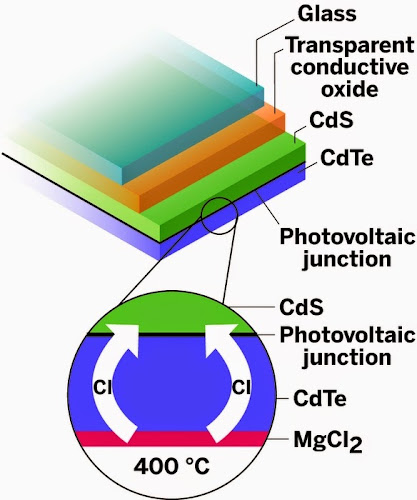Safer Salts For Solar-Cell Production Chemical and Engineering News
Matt Davenport
 |
| A magnesium salt may reduce the hazards and costs of making thin-film photovoltaic devices |
Substituting magnesium chloride for toxic cadmium chloride could free cadmium-telluride solar-cell manufacturers from a costly and hazardous process without sacrificing efficiency, according to a new study.
At the heart of a standard CdTe solar cell is a photovoltaic junction formed by the interface between neighboring thin layers of CdS and CdTe. Without processing the layers after deposition, a cell converts incident solar power into electric power with less than 5% efficiency. Manufacturers bump this up to between 10 and 20% using a junction activation step.
For more than two decades, activation has relied on CdCl2, usually deposited as a thin coating on the cell’s CdTe layer. When the cell is heated, chloride diffuses through its stacked structure and reforms the physical and electronic characteristics of the cadmium-containing layers, leaving a more efficient photovoltaic junction.
For more than two decades, activation has relied on CdCl2, usually deposited as a thin coating on the cell’s CdTe layer. When the cell is heated, chloride diffuses through its stacked structure and reforms the physical and electronic characteristics of the cadmium-containing layers, leaving a more efficient photovoltaic junction.
Read more...










































No hay comentarios:
Publicar un comentario
Bienvenido a Avibert.
Deja habilitado el acceso a tu perfil o indica un enlace a tu blog o sitio, para que la comunicación sea mas fluida.
Saludos y gracias por comentar!